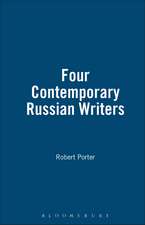Samuel Beckett in Confinement: The Politics of Closed Space: Historicizing Modernism
Autor Dr James Littleen Limba Engleză Hardback – 13 mai 2020
| Toate formatele și edițiile | Preț | Express |
|---|---|---|
| Paperback (1) | 198.22 lei 6-8 săpt. | |
| Bloomsbury Publishing – 17 noi 2021 | 198.22 lei 6-8 săpt. | |
| Hardback (1) | 602.11 lei 3-5 săpt. | |
| Bloomsbury Publishing – 13 mai 2020 | 602.11 lei 3-5 săpt. |
Din seria Historicizing Modernism
- 14%
 Preț: 540.31 lei
Preț: 540.31 lei - 30%
 Preț: 600.06 lei
Preț: 600.06 lei -
 Preț: 447.42 lei
Preț: 447.42 lei - 30%
 Preț: 715.42 lei
Preț: 715.42 lei - 30%
 Preț: 509.93 lei
Preț: 509.93 lei - 13%
 Preț: 237.84 lei
Preț: 237.84 lei - 22%
 Preț: 259.07 lei
Preț: 259.07 lei - 13%
 Preț: 255.76 lei
Preț: 255.76 lei - 22%
 Preț: 777.06 lei
Preț: 777.06 lei - 22%
 Preț: 257.68 lei
Preț: 257.68 lei - 13%
 Preț: 257.97 lei
Preț: 257.97 lei - 13%
 Preț: 256.12 lei
Preț: 256.12 lei - 22%
 Preț: 258.59 lei
Preț: 258.59 lei - 13%
 Preț: 256.29 lei
Preț: 256.29 lei - 13%
 Preț: 258.42 lei
Preț: 258.42 lei - 30%
 Preț: 716.56 lei
Preț: 716.56 lei - 22%
 Preț: 232.34 lei
Preț: 232.34 lei - 22%
 Preț: 257.32 lei
Preț: 257.32 lei - 13%
 Preț: 228.85 lei
Preț: 228.85 lei - 30%
 Preț: 657.22 lei
Preț: 657.22 lei -
 Preț: 259.07 lei
Preț: 259.07 lei - 13%
 Preț: 258.42 lei
Preț: 258.42 lei - 22%
 Preț: 258.42 lei
Preț: 258.42 lei - 13%
 Preț: 257.03 lei
Preț: 257.03 lei - 30%
 Preț: 717.05 lei
Preț: 717.05 lei - 13%
 Preț: 256.20 lei
Preț: 256.20 lei - 22%
 Preț: 259.25 lei
Preț: 259.25 lei - 30%
 Preț: 773.81 lei
Preț: 773.81 lei -
 Preț: 237.75 lei
Preț: 237.75 lei - 23%
 Preț: 236.27 lei
Preț: 236.27 lei - 13%
 Preț: 257.12 lei
Preț: 257.12 lei
Preț: 602.11 lei
Preț vechi: 860.74 lei
-30% Nou
Puncte Express: 903
Preț estimativ în valută:
115.21€ • 120.30$ • 95.14£
115.21€ • 120.30$ • 95.14£
Carte disponibilă
Livrare economică 25 martie-08 aprilie
Preluare comenzi: 021 569.72.76
Specificații
ISBN-13: 9781350112322
ISBN-10: 1350112321
Pagini: 256
Ilustrații: 9 bw illus
Dimensiuni: 156 x 234 mm
Greutate: 0.73 kg
Editura: Bloomsbury Publishing
Colecția Bloomsbury Academic
Seria Historicizing Modernism
Locul publicării:London, United Kingdom
ISBN-10: 1350112321
Pagini: 256
Ilustrații: 9 bw illus
Dimensiuni: 156 x 234 mm
Greutate: 0.73 kg
Editura: Bloomsbury Publishing
Colecția Bloomsbury Academic
Seria Historicizing Modernism
Locul publicării:London, United Kingdom
Caracteristici
Explores the full range of Beckett's writing, from the Trilogy to Waiting for Godot
Notă biografică
James Little is a postdoctoral researcher at Charles University, Prague and Visiting Professor at Masaryk University, Brno, Czech Republic.
Cuprins
AcknowledgementsAbbreviationsList of IllustrationsNotes on the TextIntroduction: Beckett's Spatial Politics1 Images of Confinement: Proust, Dream of Fair to Middling Women2 The Ethics of Writing Confinement: 'Dante and the Lobster', 'Fingal', Murphy3 'Vaguening' Confinement: Watt4 'Undoing' Confinement: 'The End', 'The Expelled', Molloy, Malone Dies5 Political Pentimenti: Waiting for Godot, Endgame6 Learning to Say 'Not I': The Unnamable7 Redoing Not I in 'Non-A'8 'The Limits of Interpretation': Imagination Dead Imagine, All Strange Away 9 The 'Anethics' of Staging Confinement: 'Mongrel Mime', CatastropheConclusion: 'Mongrel' SpaceWorks Cited
Recenzii
Little's references to recent performances of Beckett's plays in different parts of the world (be it Not I or Godot) testify to their immense potential to resonate with their audiences in various political and cultural contexts. His comprehensive and extremely well-researched investigation of Beckett's creation of confined spaces, "whether onstage or on the page" (207), by means of the genetic-critical methodology, is illuminating, persuasive and extremely well-written, and as such is a valuable scholarly resource both within and beyond Beckett studies.
What is then drawn out so meticulously in Samuel Beckett in Confinement is the playwright's rigorous refinement of stage space, stripping away, "vaguening" or "undoing," resisting specificity in order to achieve greater resonance. In Beckett's words: "As much precision as possible. But minimum of explications" (qtd. in Little 207). Gratifyingly, Little follows Beckett only in part, giving us both precision and explication in a book that adds substantially to our understanding, not simply of Beckett, but the functioning of theatre as a fundamentally spatial medium.
Once the preserve of the prisoners, lunatics and ascetics that so fascinated Samuel Beckett, confinement has become all too familiar over recent months. And while it is clearly a recurrent theme in Beckett's works, James Little's adroit study shows that it is much more than this: not only do carceral spaces prove fundamental to understanding Beckett's idiosyncratic dramatic and aesthetic visions, but his remarkable 'art of confinement' (90) also proves key to unveiling the implicit political and ethical implications of his plays and prose.
The scope of this study will make it of interest to scholars across many disciplines. [...] What Beckett in Confinement contributes to the ongoing discussion of a Beckettian politics is an understanding of how the confined spaces of his oeuvre equip readers and audiences with a set of cognitive and conceptual tools for an ethical and political analysis of closed space. Little argues that the politics of Beckett's spatial aesthetic is its resistance to the representation of enclosed spaces on the terms of the state, sidestepping hermeneutic closure to open up a multiplicity of closed spaces to socio-political critique. [...] It is a powerful argument for seeing Beckett's oeuvre as a formal engagement with politics that places the ethical question foremost, with the spatial forms of his work shaped by a relation to the inalienable alterity of confinement that retains, rather than assimilates, its difference.
It is clear that James Little's reading range is immense, and his arduous archival work makes reading his book essential for any researcher of the work of Samuel Beckett.
Little is persuasive in his claim that Beckett 'produces his stage spaces in self-conscious engagement with his socio-political context'. And he writes very beautifully of prison productions of Godot. His knowledge and command of the archive is also extraordinary.
Little joins the growing list of scholars and readers recalibrating what we might broadly call Beckett's politics as the historical arc of Beckett criticism shifts from seeing Beckett as a disengaged aesthete to something of a political philosopher. Joining these, Little takes a fresh approach to such issues as he returns to the famous confined spaces of Beckett's texts in more broadly philosophical and political terms, shifting the calculus from restriction and confinement as an "imaginative resource" to the principle of "coercive confinement" in prose and on stage, confinements often extended beyond the "seeable." Space itself is explored as a political issue. Amid a crowded field of Beckett scholarship, such recalibrations are most welcome.
James Little's Beckett in Confinement offers a brilliant analysis of the politics behind Beckett's production of closed space, both as a writer and as a director. It carefully examines the move from writing about closed space to creating an art of confinement. To argue that Beckett's use of confined space is central to the political dynamics of his works, James Little also superbly employs genetic criticism to open up the confined space of the published text and bring highly relevant draft materials back into the critical conversation.
The many characters Beckett invented share one characteristic: they are all imprisoned or trapped in some way, no matter where they are. Samuel Beckett in Confinement: The Politics of Closed Space draws on untapped riches from Beckett's correspondence and the archives to reconsider the obsession with entrapment, coercion and detention central to Beckett's varied oeuvre. In this exciting and illuminating analysis, James Little offers a fresh and original reading of the work's ethical and political dimensions, and shows us why we need to stop thinking about confinement as a metaphysical metaphor.
What is then drawn out so meticulously in Samuel Beckett in Confinement is the playwright's rigorous refinement of stage space, stripping away, "vaguening" or "undoing," resisting specificity in order to achieve greater resonance. In Beckett's words: "As much precision as possible. But minimum of explications" (qtd. in Little 207). Gratifyingly, Little follows Beckett only in part, giving us both precision and explication in a book that adds substantially to our understanding, not simply of Beckett, but the functioning of theatre as a fundamentally spatial medium.
Once the preserve of the prisoners, lunatics and ascetics that so fascinated Samuel Beckett, confinement has become all too familiar over recent months. And while it is clearly a recurrent theme in Beckett's works, James Little's adroit study shows that it is much more than this: not only do carceral spaces prove fundamental to understanding Beckett's idiosyncratic dramatic and aesthetic visions, but his remarkable 'art of confinement' (90) also proves key to unveiling the implicit political and ethical implications of his plays and prose.
The scope of this study will make it of interest to scholars across many disciplines. [...] What Beckett in Confinement contributes to the ongoing discussion of a Beckettian politics is an understanding of how the confined spaces of his oeuvre equip readers and audiences with a set of cognitive and conceptual tools for an ethical and political analysis of closed space. Little argues that the politics of Beckett's spatial aesthetic is its resistance to the representation of enclosed spaces on the terms of the state, sidestepping hermeneutic closure to open up a multiplicity of closed spaces to socio-political critique. [...] It is a powerful argument for seeing Beckett's oeuvre as a formal engagement with politics that places the ethical question foremost, with the spatial forms of his work shaped by a relation to the inalienable alterity of confinement that retains, rather than assimilates, its difference.
It is clear that James Little's reading range is immense, and his arduous archival work makes reading his book essential for any researcher of the work of Samuel Beckett.
Little is persuasive in his claim that Beckett 'produces his stage spaces in self-conscious engagement with his socio-political context'. And he writes very beautifully of prison productions of Godot. His knowledge and command of the archive is also extraordinary.
Little joins the growing list of scholars and readers recalibrating what we might broadly call Beckett's politics as the historical arc of Beckett criticism shifts from seeing Beckett as a disengaged aesthete to something of a political philosopher. Joining these, Little takes a fresh approach to such issues as he returns to the famous confined spaces of Beckett's texts in more broadly philosophical and political terms, shifting the calculus from restriction and confinement as an "imaginative resource" to the principle of "coercive confinement" in prose and on stage, confinements often extended beyond the "seeable." Space itself is explored as a political issue. Amid a crowded field of Beckett scholarship, such recalibrations are most welcome.
James Little's Beckett in Confinement offers a brilliant analysis of the politics behind Beckett's production of closed space, both as a writer and as a director. It carefully examines the move from writing about closed space to creating an art of confinement. To argue that Beckett's use of confined space is central to the political dynamics of his works, James Little also superbly employs genetic criticism to open up the confined space of the published text and bring highly relevant draft materials back into the critical conversation.
The many characters Beckett invented share one characteristic: they are all imprisoned or trapped in some way, no matter where they are. Samuel Beckett in Confinement: The Politics of Closed Space draws on untapped riches from Beckett's correspondence and the archives to reconsider the obsession with entrapment, coercion and detention central to Beckett's varied oeuvre. In this exciting and illuminating analysis, James Little offers a fresh and original reading of the work's ethical and political dimensions, and shows us why we need to stop thinking about confinement as a metaphysical metaphor.



















